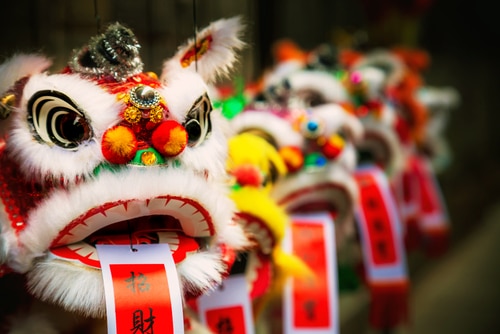The Chinese New Year story
Chinese New Year, also called Spring Festival or Lunar New Year is the oldest traditional festival in China, but where does the origin and story behind the holiday come from? Many existing customs and activities of the festival can be traced back to a popular story of the Monster Nian, which helps to explain why and how the festival is celebrated. So, why not teach your class the story of the Chinese New Year and how it all started?
How did Chinese New Year start?
The origins of the Chinese New Year are steeped in legend. One legend is that thousands of years ago a monster named Nian (“Year”) would attack villagers at the beginning of each new year. The monster was afraid of loud noises, bright lights, and the colour red, so those things were used to chase the beast away. Celebrations to usher out the old year and bring forth the luck and prosperity of the new one. Therefore, often include firecrackers, fireworks, and red clothes and decorations. Young people are given money in colourful red envelopes. In addition, the Chinese New Year is a time to feast and visit family members. Check out this video on the Chinese New Year story for more background.
Many of the traditions are inherited till today. According to the story, Chinese New Year’s Day or the Spring Festival is also called “Guo Nian”, which means surviving in the Nian’s attack. Red has become the most popular colour for festival celebrations and dress codes.
Chinese New Year traditions
Among other Chinese New Year traditions is the thorough cleaning of one’s home to rid the resident of any lingering bad luck. Some people prepare and enjoy special foods on certain days during the celebrations. Finally, the last event held during the Chinese New Year is called the Lantern Festival. This is where people hang glowing lanterns in temples or carry them during a night-time parade. Since the dragon is a Chinese symbol of good fortune, a dragon dance highlights festival celebrations in many areas. This procession involves a long, colourful dragon being carried through the streets by numerous dancers.
The year of the Rabbit
Chinese New Year 2023 Year of the Rabbit starts on the 22nd of January and ends on the 9th of February 2024. The Lunar New Year, or Spring Festival, as it’s otherwise known begins on the new moon, and ends on the full moon – lasting around 15 days. On the final day, a Lantern Festival is held, symbolising letting go of the old.
This Chinese New Year 2023 is the Year of the Water Rabbit. The rabbit in Chinese culture can be used to symbolise the moon – this comes from an ancient legend called the Jade Rabbit.
There are 12 animals in the Chinese Zodiac, and the rabbit is believed to be the luckiest of them all. There is a belief that we carry characteristics of the Zodiac animal that we are born under. Rabbits are believed to be witty, vigilant, and ingenious.

Will this year of the Rabbit be the luckiest?
Although the rabbit is believed to be the luckiest, this has not always been so… When the legendary Jade Emperor was looking to order the Zodiac animals, he arranged a race which would decide on the ordering of the Zodiac animals. The rabbit is the fourth Zodiac sign, so if he is the luckiest, then why did he not come first? The rabbit, in its haste, which is sometimes regarded as arrogance, set off early but decided to hit the sack. Consequently, three other animals passed it and finished the race first.
Why is Chinese New Year an important subject for children?
Teaching children about the Chinese New Year is an opportunity to introduce them to the concept of diversity. The Chinese New Year 2023 will be celebrated by many people across the globe. Children are naturally curious and like to learn about the similarities and differences that they share with their peers. For that reason, introducing young children to different cultures by having them take part in cultural festivities is the perfect way to stamp out prejudices in the Early Years. As a result, it helps them to grow cultural respect and awareness that they will carry through into adulthood.
How can you celebrate in your classroom?
The Lantern Festival, also called Shangyuan Festival, is celebrated on the fifteenth day of the first month in the Chinese calendar. This means there is plenty of time to incorporate the traditions of the holiday into your classroom.
Some ideas can include creating and decorating traditional banners, learning the vocabulary and meaning of typical New Year symbols, and practicing greetings. Pupils often enjoy exploring the animals of the Chinese Zodiac. Lastly, creating paper lanterns is a simple craft you could do as a class. Consider spacing out your activities throughout the week. This means that pupils can get a true sense of the scale and importance of the holiday for people of Chinese descent.
Celebrate Chinese New Year with your class and teach them the story behind how it first started. Get them to learn about different cultures that happen all around the world and take part in the festivities. For more information, check out our previous blog on 5 Chinese New Year teaching ideas.
Let us know how your class celebrates Chinese New Year and send in your pictures on Instagram and Twitter.






